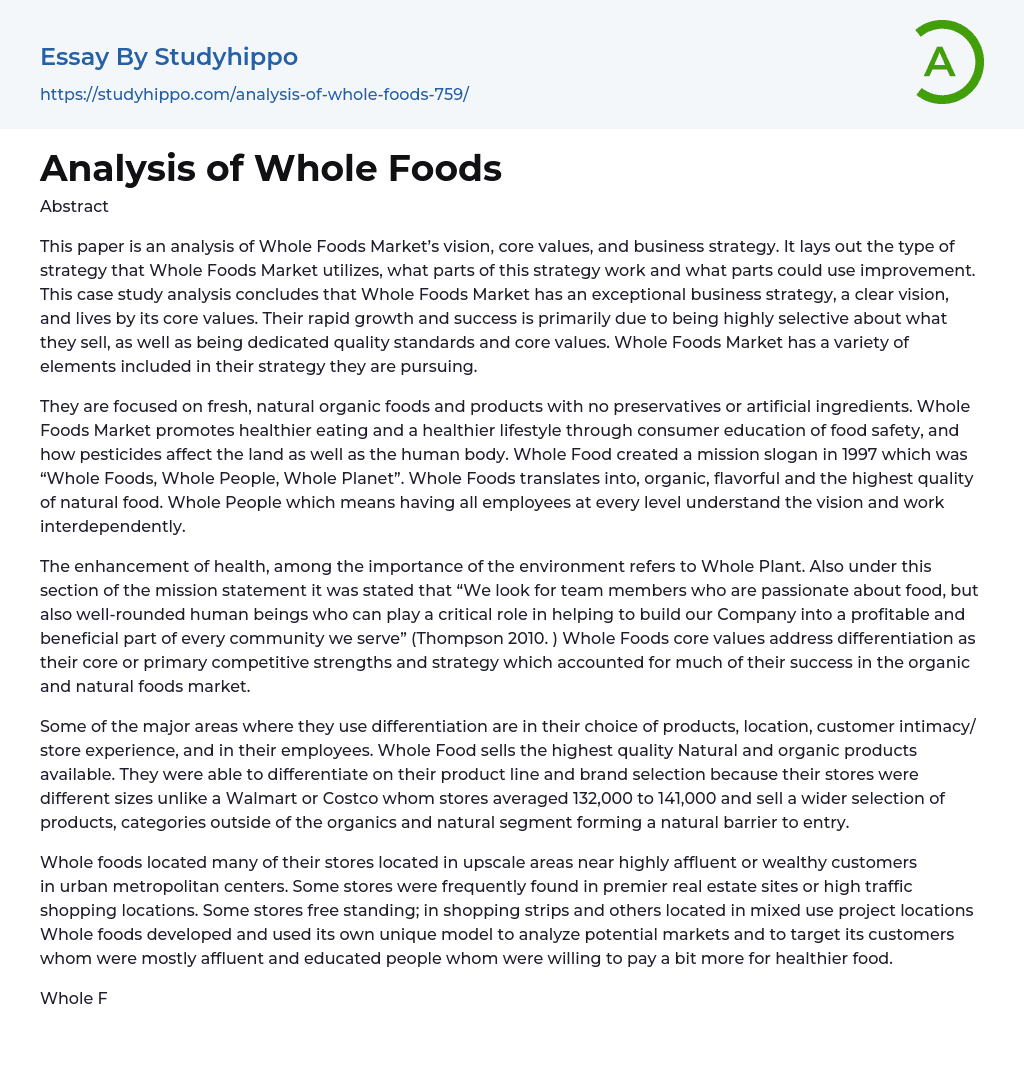Abstract This analysis evaluates Whole Foods Market’s vision, core values, and business strategy. It assesses the effectiveness of their strategy and identifies areas for improvement. The conclusion is that Whole Foods Market has a remarkable business strategy, a clear vision, and remains loyal to its core values. Their exceptional growth and achievement can be attributed to their careful product selection, dedication to quality standards, and commitment to core values. Whole Foods Market incorporates multiple elements into their pursued strategy.
Whole Foods Market is dedicated to providing fresh, natural, and organic foods and products that are free from preservatives and artificial ingredients. They aim to educate consumers about the importance of food safety and the impact of pesticides on both the environment and human health in order to encourage healthier eating habits and lifestyles. In 1997, Whole Foods introduced their
...mission slogan: "Whole Foods, Whole People, Whole Planet," which showcases their commitment to offering organic, flavorful, and high-quality natural foods. Furthermore, the idea of "Whole People" emphasizes the importance of fostering a shared vision among employees at all levels and promoting collaboration within the organization.
The concept of enhancing health through the environment is called Whole Plant. In their mission statement, Whole Foods expresses the desire to have team members who are not only passionate about food but also well-rounded individuals who can contribute to making the company profitable and beneficial in every community they serve (Thompson 2010). Differentiation is emphasized by Whole Foods as their main competitive advantage and strategy, which has greatly contributed to their success in the organic and natural foods market.
Some of the main areas where differentiation is utilized include the choice of products,
location, customer intimacy/store experience, and employees. Whole Foods sets itself apart by offering the highest quality Natural and organic products. The company is able to differentiate itself through its product line and brand selection, as its stores vary in size. This distinguishes Whole Foods from larger retailers like Walmart or Costco, whose stores average 132,000 to 141,000 square feet and offer a wider selection of products across various categories beyond organic and natural items, thereby establishing a natural barrier to entry.
Whole Foods strategically places their stores in upscale areas near wealthy customers in urban metropolitan centers. They often choose premier real estate sites or high traffic shopping locations for their stores. Some are standalone, while others are located in shopping strips or mixed-use projects. Whole Foods has developed a unique model to analyze potential markets and target their customers, who are typically affluent and educated individuals willing to pay extra for healthier food.
Whole Foods employs a combination of education levels, population density, and income to determine potential store locations. These projections are made based on specific drive times at each location, and only after meeting certain financial requirements. As of now, Whole Foods operates more than 274 stores in 36 states and internationally. They primarily source their organic and natural foods from individual or subsidized farmers and seafood fisheries (Thompson 2011).
Whole Foods has established special partnerships and initiatives to guarantee the highest standards in their products and future attributes of organic and natural foods. They assist farmers in underprivileged or economically challenged regions or nations via their Whole Trade program. The company is dedicated to sourcing more than half of its products from developing countries,
remunerating small-scale producers a fair price that encompasses their expenses and empowers them to invest in their families and employees. This contributes to improving livelihoods by facilitating education and adequate wages.
Whole Foods aims to establish a feeling of familiarity among its customers by fostering a strong corporate culture that encourages collaborative teamwork in fulfilling the company's mission. This emphasis on teamwork is essential for improving the overall customer experience. Whole Foods grants these teams the power to make decisions concerning store-level merchandising, departmental operations, and customer satisfaction.
Whole Foods implements this model because they are dedicated to ensuring customer satisfaction as a key factor for their long-term success. By empowering team leaders and employees, they are motivated and inspired, which helps them utilize the collective energy of the team and effectively manage their store compared to competitors.
In addition, the team members and employees at Whole Foods Market had both decision-making authority and job satisfaction, leading to a greater sense of purpose. Their motivation came from their dedication to the company's mission of promoting healthy diets, eating habits, and overall societal well-being. This has made Whole Foods Market stand out as a robust organization with a bright future.
Whole Foods Market has implemented proactive measures to address economic challenges, which have led to ongoing growth, improved operating efficiency, and increased capital. The company's strategic plans for growth prioritize the expansion of private label products to enhance price points, differentiation, and value. These efforts are crucial for the company's future successes (Thompson, 2010; Thompson, 2011).
- Food Safety essays
- Food Security essays
- Beverages essays
- Cuisines essays
- Dairy essays
- Desserts essays
- Fast Food essays
- Bread essays
- Meal essays
- Meat essays
- Organic Food essays
- Rice essays
- Sugar essays
- Taste essays
- Beef essays
- Coconut essays
- Crowd essays
- Dinner essays
- Juice essays
- Sainsbury essays
- Cooking essays
- Ginger essays
- Oreo essays
- Drink essays
- Beer essays
- Wine essays
- Coffee essays
- Tea essays
- Cake essays
- Hamburger essays
- Ice Cream essays
- Burger essays
- Pizza essays
- Fruit essays
- Lemon essays
- Food Waste essays
- Favorite Food essays
- Alcoholic essays
- Soft Drinks essays
- Cookie essays
- Starch essays
- Yeast essays
- Cola essays
- Pizza Hut essays
- snack foods essays
- chips essays
- Biscuit essays
- Brewing essays
- Brewery essays
- Anorexia essays




